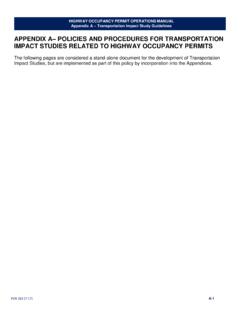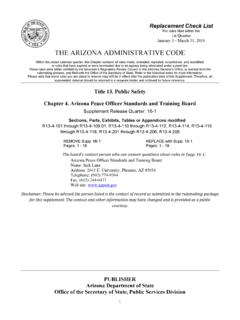Transcription of Police Officers Crash Report Manual
1 PUB 153 (9-21) Police Officers Crash Report ManualPennsylvania Publication 153 ITABLE OF CONTENTSI ntroduction .. 1 Definitions and Terminology .. 1 Submitting Reports to PennDOT .. 4 Completing the Police Crash Report Form Police Agency Data .. 6 Crash Data .. 6 Location Data .. 7 Unit Data .. 9 Vehicle Data .. 10 People Data .. 11 General Crash Data .. 12 Unit Harmful Event Data .. 13 First/Most Harmful Event Data .. 14 Contributing Factors Data .. 14 Prime Factor Data .. 14 Diagram/Narrative .. 14 Commercial Vehicle Data .. 15 Fatal Crash Data .. 15 Motorcycle Crash Data .. 15 Pedestrian Crash Data .. 16 Work Zone Crash Data .. 16 Updating/Deleting Information .. 16 IITABLE OF CONTENTSA ppendix County Codes .. 17 North American Postal Codes .. 18 Modern Roundabout Locations .. 19 Crash Scenarios .. 20 How to Locate a Midblock Crash .. 20 How to Locate a Ramp Crash .. 21 Non-fatal Crashes with Fatalities .. 22 Private Property/ Parking Lot Crashes .. 22 Struck by Thrown Object.
2 22 County Maps .. 23 GPS format Conversion.. 23 Vehicle Types.. 24 1 INTRODUCTION Section 3751 of Title 75, Pennsylvania s Consolidated Statutes (Vehicle Code) requires Police agencies to investigate, upon notification, all crashes involving death, injury, and/or damage to any one vehicle to such an extent that it cannot be driven from the scene without further damage and therefore requires towing. Furthermore, the investigating agency must Report these crashes within 15 days to the Department of Transportation on a form designed and supplied by the Department (Section 3752(b)). That form is the Commonwealth of Pennsylvania Police Crash Report (PCR) Form which now is defined by a data standard for electronic submission. This data standard shall change in accordance with the needs of applicable Federal and State agencies and with legislative changes regarding collection of Crash data. Crashes are, too often, a failure in the Commonwealth's Transportation System. The primary objective when investigating crashes is to obtain information that can be used to develop Crash prevention and Crash reduction programs.
3 The PCR form has been designed to assist Officers in doing just that. It is the primary source document for Pennsylvania's Crash Reporting System. Every attempt must be made to obtain factual information for all items listed on the Report form. It has been designed to be easily completed and to assist Officers in gathering the information consistent with their responsibilities at the scene of a Crash . Compliance with instructions in this Manual will help assure that reports are filled out completely, accurately, and in a uniform manner. DEFINITIONS AND TERMINOLOGY From time to time, Police Officers will call PennDOT with questions regarding a particular Crash . Generally, the questions result from an unusual situation in the Crash . The following is a partial list of terms and definitions that may help Officers determine the answers to those questions. However, if you are still unsure, please give us a call. The number is (717) 787 2855. Crash A Crash is a sequence of events that result in an un stabilized situation which includes at least one incident of personal injury or vehicular damage that is not a direct result of a cataclysm or deliberate intent.
4 UNSTAbILIZED Crash SITUATIONS An unstabilized situation is a set of events not under human control. It originates when control is lost and terminates when control is regained or when all persons and property are at rest. Examples of unstabilized situations: Unit #1 strikes Unit #2. After this collision, Unit #1 crosses the median still out of control and strikes Unit #3. This will be reported as a three (3) vehicle Crash because Operator #1 had not regained control of their unit before striking Unit #3. If part of a load (or chunk of ice) falls from a vehicle, and in the process of falling strikes another vehicle, then the resultant Crash would be considered a two (2) vehicle Crash . Examples where situations stabilize and then are lost: Unit #1 strikes Unit #2. After this collision, Unit #1 comes to rest in the opposing lane of travel. Unit #3 then comes along and strikes Unit #1. This will be reported as two (2) separate crashes the first as a two (2) vehicle Crash and the second as a two (2) vehicle Crash with the previously wrecked unit having a value of Disabled From Previous Crash in the Type Unit field because the first situation had become stable when the first two units came to rest.
5 If as a result of a Crash , part of a load falls to the ground and moments later the load is struck by a second vehicle, then the resultant second Crash would involve a single vehicle as the situation had stabilized after the fall. MOTOR VEHICLE IN TRANSPORT A motor vehicle in transport is any motorized vehicle moving or stopped during its course of transit (not parked). This includes driverless vehicles in motion. Motorized pedestrian mobility devices such as wheelchairs and mobility scooters are not considered to be motor vehicles. There must be at least one motor vehicle in transport involved in every Crash reported to PennDOT. 2 REPORTAbLE Crash The incident must occur on a highway or trafficway that is open to the public by right or custom and involve at least one motor vehicle in transport. This can be if control is lost on the roadway or if any of the harmful events occur on the roadway. The definition for a reportable Crash can be found in Section 3746(a) of Title 75, Pennsylvania's Consolidated Statutes.
6 It states a Crash is reportable if it involves: Injury to or death of any person; and/or Damage to any vehicle to the extent that it cannot be driven under its own power in its customary manner without further damage or hazard to the vehicle, other traffic elements, or the roadway, and therefore requires towing. See the Appendix for reportability examples. Crashes involving a Snowmobile or AT V should be reported by the driver using form 8170 FM FR0061 Department of Conservation and Natural Resources, Bureau of Forestry, PO Box 8552, Harrisburg, PA 17105. It is a violation of the Snowmobile/ATV Law not to Report an accident anywhere in Pennsylvania involving death, injury or damage in excess of $100. School Bus Crashes must be reported by the driver/bus service to the PennDOT School Bus Unit using form DL 739A. Damage to PennDOT maintained property such as guide rails and signage should always be reported to the PennDOT District Office. Please also mark the PennDOT Property Damage box on the form.
7 NON-REPORTAbLE Crash A non reportable Crash involves a Crash with no injury or death of any person, in which there is no towing due to the damage to the vehicle at the time of the Crash . Furthermore, if the incident occurred on private property or was a result of deliberate intent or cataclysm, the Crash is non reportable. A non reportable Crash does not require a Police Crash Report to be submitted. CATACLYSM A cataclysm is a landslide, cyclone, earthquake, flash flood, hurricane, lightning, tornado, etc. Crashes that result from a cataclysm are not reportable. Examples: Motor vehicles driven into water when a bridge is washed out during a flood. Motor vehicles driven into or struck by falling materials during a landslide. Motor vehicles struck by trees, tree limbs or other large debris during a major storm DELIbERATE INTENT The classification given to the cause of an event which occurs when a person acts deliberately to cause the event or deliberately refrains from prudent acts, which would prevent occurrence of the event.
8 This includes suicide, self inflicted injury, homicide, injury or damage purposely inflicted. Crashes that result from deliberate intent are not reportable. Examples of deliberate intent include: Passenger deliberately exiting a moving vehicle Bystander deliberately throwing objects at or firing into a moving vehicle Driver deliberately driving into another vehicle, pedestrian, or fixed object, or driving off the roadway with blatant disregard for the safety of the action. Passenger interfering with the driver such as grabbing the steering wheel 3 LEGAL INTERVENTION A category of deliberate intent which involves an action by a law enforcing agent or authorized official. Crashes that result from legal intervention are not reportable. Examples: If a lawbreaker crashes either intentionally or unintentionally into a roadblock set up by Police to stop them, then the Crash is considered a result of legal intervention. If a Police car is intentionally driven into another vehicle, the Crash is considered to result from legal intervention.
9 If a vehicle being pursued by the Police loses control and crashes into another, the Crash is not considered to be a result of legal intervention because neither the officer nor the pursuant intend this Crash . HARMFUL EVENT A harmful event is an occurrence that actually causes damage or injury. It must be observable like hitting a tree or overturning. The event itself causes the damage or injury. There can be up to four harmful events per unit per Crash . If there are more for a particular vehicle, use the first four harmful events in event sequence (how it happened) and ignore the remaining events. If the most harmful event is not one of the first four, make it the fourth harmful event and ignore the original fourth harmful event in sequence. The investigating officer will determine the most damaging or injury producing event for each unit based upon their investigation. NON-COLLISION Crash A non collision Crash is any Crash that does not involve contact between units or a motor vehicle and a fixed object.
10 A Police Crash Report Form should be prepared if the resultant incident meets the definition of a reportable Crash . Examples: Occupant falling from exterior of vehicle (motorcycle, pick up bed, etc.) Vehicle roll over (not preceded by a collision) Breakage of any part of the vehicle, resulting in injury or further property damage Fire starting in the vehicle or mechanical failure while in motion (not parked) Occupant hit by an object in, or thrown against some part of the vehicle Object falling on the vehicle (not from another unit). PHANTOM UNIT A phantom unit has a contributing factor in the Crash but does not have any harmful events. This can include pedestrians. There should be evidence or witness statements to corroborate a phantom unit. Phantom Units should now be coded with a harmful event of 00 = No harmful event (Phantom Unit) AUTOCYCLE A new vehicle category has been established under Pennsylvania law and must be tracked as a separate vehicle type in the Crash reporting system.











